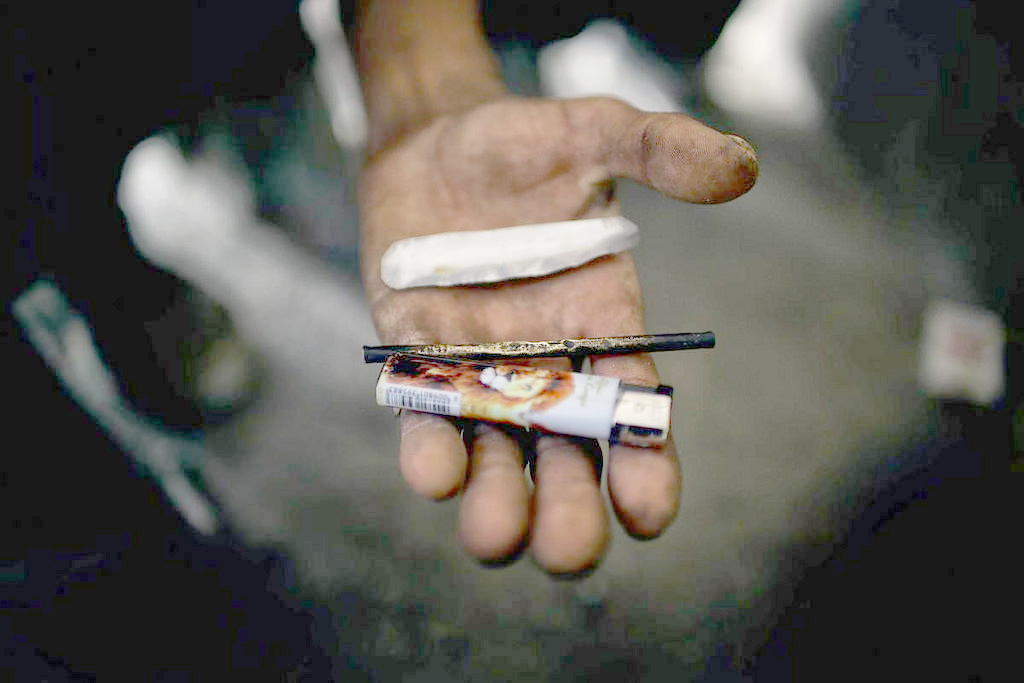“You see a lot of them where their parents used. Introduced them to heroin at the age of 10. Shot them up at the age of 10. Put them out there for prostitution. That’s horrible. That’s not their fault.”
Darcy Thompson has seen a lot at her job at a rehab facility for drug addictions, including people who became addicted to heroin at the young age of 10. The effects of heroin in Dayton has made the facility full and forced them to turn people away.
Eric Harshbarger, the Montgomery County coroner, has also been feeling the impact of the heroin epidemic in Dayton.
“We used to, five years ago, have an easy shift and it’s just now there’s no downtime at all. So it’s becoming overwhelming,” he said.
This overflow of heroin into the city of Dayton, has the coroner’s office feeling overworked and overrun Harshbarger said.
“We’re on the pace now to do, the last 3 years I think we’ve set record numbers of autopsies and investigations… You know we just don’t have the staff to handle this kind of workload,” he said.
In 2016, the number of overdose visits to the Emergency Department was 2,657. Montgomery County has the second highest drug overdose rate in the state.
Ohio Attorney General Mike DeWine said in an interview with 60 Minutes in November of 2015 that this is “the worst drug epidemic I’ve seen in my lifetime… It just has permeated every segment of society in Ohio. There is no place in Ohio where you can hide from it.”
According to Harshbarger, responding to a heroin overdose is just like responding to any other call; however, the amount of times the coroner’s office is responding is what makes them unique.
“There’s nothing unique in responding to a drug overdose, but what’s different now is just the volume. It’s getting overwhelming. It’s just they’re responding everyday,” he said.
It is not just the amount of dead bodies flowing into coroners’ offices or the amount of heroin coming into the streets of Dayton.
According to Janice Mains, the head of the Nursing Department at Sinclair Community College, the impact of heroin can be felt everywhere.
“From a nursing standpoint, our concern is that it’s like any addiction and it affects the individual, the family, the community. I mean, it’s devastating at all levels,” she said.
Heroin, Mains said, not only brings devastation to families and communities, but it also affects the user’s ability to function.
“You see how it affects people’s ability to perform in their best interests. I mean, it’s like any addiction. The scary thing about heroin, it is so available and it’s so heavily addictive,” she said.
This heavily addictive drug shows its danger in the addict’s life. “It rips people’s lives apart, it totally rips them apart.”
The addiction to heroin is often because, according to Thompson, the addict needs a way to cope with what was happened in their lives. The majority of users, she says, are often victims of sexual assault.
“I would say that 75 percent of these people were abused, molested and that’s where the coping mechanism comes in,” she says.
The treatment to this way of coping, Thompson said, is getting to the real heart of the problem, not just the addiction itself.
“The new sort of way to deal with addictions is where you’re going in and getting to the root of the problem. And that’s really what it’s about. The drug addiction and all that, that’s just how they’re coping. They learn how to cope when bad things happen,” Thompson said.
Captain Mike Brem, the Montgomery County Sheriff’s Department’s Drug Task Force commander, has been a part of the change in police work due to heroin.
According to Brem, it is important to respond on all cylinders and stop the demand of heroin in Dayton.
One of the steps he said they have taken to stop the amount of overdose deaths is the use of an antidote medication.
The first responders in the city of Dayton have started carrying this antidote medication that is designed to help prevent overdose deaths. According to Harshbarger, the medication has been incredibly helpful.
In 2016, in a study released by the Henry J. Kaiser Family Foundation, Ohio led the way with the number of opioid deaths per states. Dayton is also still one of the worst cities for heroin overdoses.
The antidote medication, Narcan, is designed to combat an overdose by reversing the symptoms. It does produce withdrawal symptoms; however, they are not life threatening.
Critics of Narcan say that using the antidote encourages drug use because users know that they can be revived. Maine’s governor, Paul LePage, vetoed a bill that would allow pharmacists to dispense the drug without a prescription, saying in his veto that “Naloxone[Narcan] does not truly save lives; it merely extends them until the next overdose.”
Thompson fought back against this idea saying that Narcan has saved many heroin users lives, giving them another chance to change and overcome their addiction.
“They’re gonna do drugs regardless. Narcan has saved a lot of people. That’s not even an issue. The addiction to that heroin is so high, they don’t care. Narcan is just something that we, thank God, we have,” she said.
Mains has seen the change in police efforts because of heroin and the antidote medication in her nursing field.
“It’s totally changed police work. I mean they’re carrying the medicine [Narcan] to reverse the effects of the overdose. So it’s really turned the whole community upside down,” she said.
However, according to Harshbarger, heroin addicts are turning to a more lethal drug, known as fentanyl. This choice is contributing to the high amount of overdoses occurring.
“I’m not sure that the user knows that they’re getting fentanyl. What we’re seeing is that user are seeking out a more “powerful heroin” and it turns out that it’s fentanyl,” he said.
Brem said that it is important to stop heroin and fentanyl by educating the public and for colleges to hold prevention talks about drugs.
Thompson has seen the levels of devastation at her job and she said that addicts are more than just junkies who live on the street.
“The clients, they can be teachers and such good people. Artists, musicians, so talented, they’re just wonderful people. [It could happen] to anyone, anybody,” she said.
According to Thompson, there is hope and a way out of the addiction and that people who get help often have a new outlook on life.
“Guys and girls leave there with such good insight. They leave with such empathy, sympathy, compassion. The tools that we give them allow them to see others issues and problems. You know, it’s amazing to see that,” she said.
For the heroin addicts whose parents introduced them to it and shot them up at young ages, Thompson says that they don’t have to be addicted anymore.
“They didn’t have a choice. They have a choice now. They can make a change.”
Laina Yost
Managing Editor


